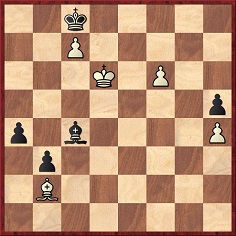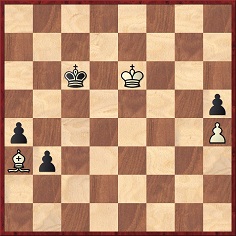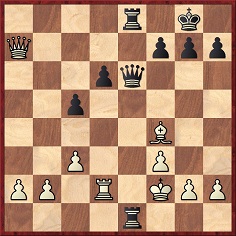Chess Notes
Edward Winter
When contacting us by e-mail, correspondents are asked to include their name and full postal address and, when providing information, to quote exact book and magazine sources. The word ‘chess’ needs to appear in the subject-line or in the message itself.
| First column | << previous | Archives [174] | next >> | Current column |
11161. Courtesy
In a letter dated 24 March 1962 John Vining of London wrote on page 262 of the June 1962 CHESS:
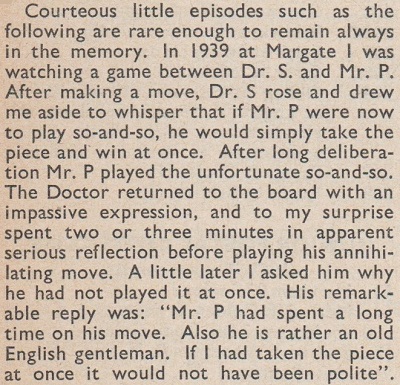
11162. Fraser v N.N. (C.N. 11149)
Alan McGowan (Waterloo, Canada) draws attention to his feature on Dr James Cunningham Fraser (1825-76) at the Chess Scotland website.
11163.
Bonar Law v Aurbach
Mr McGowan also submits a cutting about Andrew Bonar Law from the chess column in the 19 October 1921 edition of the Falkirk Herald, page 4:

The establishment in Paris, mentioned in C.N. 10114, was the Café de la Rotonde au Palais-Royal.
11164. Humour in the opening
How did this position arise?
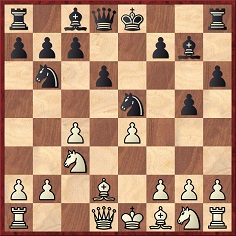
Black to move
It comes from a game between C.J.S. Purdy and F.A. Crowl (Melbourne, 29 December 1934 – see page 9 of the Sydney Daily Telegraph of 31 December 1934) which Purdy annotated on pages 317-318 of the November 1936 issue of the Australasian Chess Review under the heading ‘Humour in the Opening’.
Purdy began:
‘Little humour is to be found in the chess openings, a field that is sacrosanct to serious-minded theorists. The following game, however, contains a genuine piece of sheer buffoonery (unintentional) within the first dozen moves. Played in the fourth round of the last Australian championship tournament (Melbourne 1934-35), it is a disgrace to both contestants, but none the less entertaining for that.’
The full score, with Purdy’s punctuation:
1 c4 Nf6 2 d4 e5 3 dxe5 Ng4 4 Bf4 g5 5 Bd2! Nxe5 6 e4 Bg7 7 Nc3 d6 8 Qh5!? h6 9 Be2??? Nbd7 10 Bf1!! Nb6 11 Qd1!!! Be6 12 b3 Qd7 13 Be2! O-O-O 14 Nf3 Ng6 15 Qc2 g4 16 Ng1!! f5 17 exf5 Bxf5 18 Bd3 Rde8+ 19 Nge2 Rhf8 20 Bxf5 Rxf5 21 O-O-O Nh4 22 Nf4 Qf7 23 g3 Nf3 24 Be3 Qf6 25 Nb1! Kb8!? 26 h3 Qa1!? 27 Nd5 Nxd5 28 cxd5 Rf7 29 hxg4 Rfe7 30 Rd3 Ne5 31 Rd4 Nc6 32 Ra4 Nd4 33 Qd2 Nb5 34 Kc2 Nc3 35 Nxc3 Qxh1 36 Bxa7+ Kc8 37 Be3 Kd7? 38 Qd3 Rb8 39 g5 Bxc3 40 Kxc3 Qa1+ 41 Kc2 b5 42 Ra7 h5 43 Qf5+? Kd8 44 Qf8+ Re8 45 Qf7 Re7 46 Qxh5 Qe5 47 Qf3 Ke8 48 Qf6 Qe4+ 49 Kb2 Kd7 50 Qd4 Qxd4+ 51 Bxd4 Re2+ 52 Kc3 Rg8 53 Be3 Rg6 54 Kb4 Rxe3 55 fxe3 Rxg5 56 Kxb5 Rxd5+ 57 Kc4 Rg5 58 e4 Kc6 59 b4 Rxg3 60 a4 Kb6 61 Ra8 Kb7 62 Re8 Rg1 63 Re7 Rc1+ 64 Kb5 Ka7 65 e5 dxe5 66 Rxe5 Kb7 67 Re7 Ka7 68 a5 Kb8 69 Re5 Rd1 70 Re6 Rd8? 71 Kc6 Rh8 72 b5 Rg8 73 a6 Rd8? 74 a7+ Kxa7 75 Kxc7 Resigns.
A note in the middle-game is of interest:
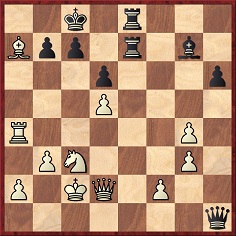
Position before 37 Be3 Kd7
[37 Be3] ‘White’s sealed move, virtually forced. Now, a remarkable instance of the psychological factor in chess is that Crowl, in spite of having an hour for private analysis, and being certain of White’s sealed move, made a gross blunder immediately on resuming. He had failed to adjust himself to the fact that White had completely recovered his lost ground. He had therefore examined only defensive moves for White. This shows that it is much better to recover from a bad game than to have an equal game all the time.’
Finally, Purdy called 70...Rd8 ‘the losing move’, adding this maxim in bold type:
‘Avoid using a rook for defence.’
11165. 64
- ‘Bobby Fischer died in Iceland of kidney failure on 17 January 2008 at age 64 – the exact number of squares on the chessboard.’
Page 314 of This Crazy World of Chess by Larry Evans (Las Vegas, 2009).
- ‘... he died at the iconic age of 64.’
Page 26 of Battle of Bonn by Raymond Keene and Eric Schiller (2008).
- ‘ ... [Fischer] moved to Iceland and died there at the iconic age of 64, the number of squares on the chessboard!’
Page 123 of Carlsen-Anand Match for the World Chess Championship by Raymond Keene (New York, 2013).
- ‘Iconically, Fischer died in 2008 in Reykjavik, the scene of his 1972 triumph, at the age of 64, the number of squares on the chessboard.’
Page 29 of Carlsen v Caruana: FIDE World Chess Championship, London 2018 by Raymond Keene and Byron Jacobs (London, 2018).
- ‘Upon Fischer’s death in 2008 at the age of 64 for 64 squares of the chess board, many where [sic] sad ...’
Page 8 of A Guide Book Of Places To Go and People You Will See Around NY Chess by Peter Julius Sloan (2012).
- ‘On 17 January 2008 Robert James Fischer died at the age of 64 – one year for every square on the chess board ...’
Page 192 of The Big Book of World Chess Championships by Andre Schulz (Alkmaar, 2016).
- ‘He died from renal failure, after refusing medical treatment from fear of being poisoned, at the symbolic age of 64 (the number of squares on a chessboard).’
Page 113 of The Psychology of Chess by Fernand Gobet (Abingdon, 2019).
How often has anyone bothered making such a point about, for instance, Steinitz?
11166. Psychology
Below is a remark by G.H. Diggle from an article in the December 1981 Newsflash which was reproduced on page 78 of Chess Characters (Geneva, 1984). See too C.N. 7805.
‘Sixty years ago there were dotted around the provinces (either in small struggling clubs or once a week in “private house soirées”) players with only each other’s chess intellects to feed on who would loyally stick to the game without improving one iota through whole decades. ... Many of them were characters of as great psychological interest as a Fischer or a Korchnoi; for to imagine that “psychological motifs” and whatnot are the exclusive monopoly of grandmasters is to fall into the snobbish fallacy of the Sergeant Major who (when a poor Private reported sick with a “pain in the abdomen”) roared at him: “You ’ave a stummick! Only orficers has abdomens!’
11167. ‘Before the death of Alekhine in 1946’
An unfathomable claim about FIDE on pages 288-289 of Who Was The Strongest? by Raymond Keene, Nathan Divinsky and Jeff Sonas (Aylesbeare, 2006):
‘Three years later [in 1993] Kasparov annihilated Nigel Short in a match that was held outside the auspices of FIDE, the World Chess Federation, which had shown itself increasingly incompetent to handle events at the highest level. FIDE soldiered gamely on with its own championship, much as it did before the death of Alekhine in 1946, but FIDE always had to make do without the world’s top two players at any given time.’
11168. Vogue
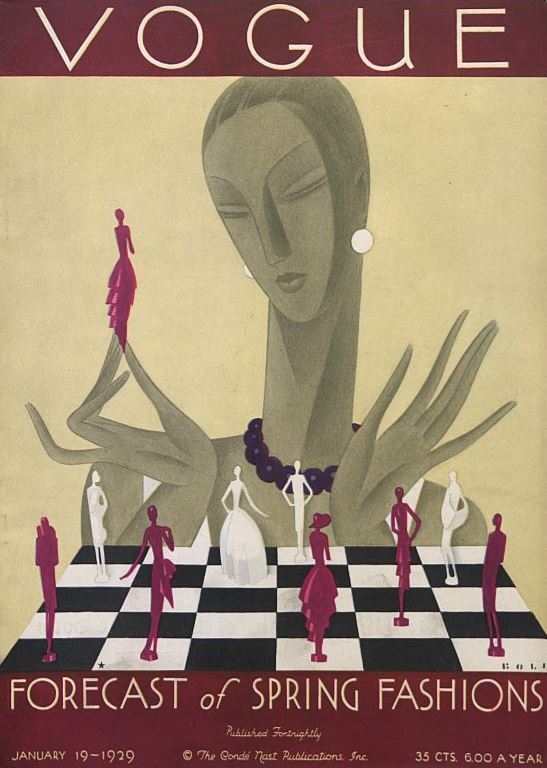
11169. Reshevsky v Fischer

The above snippet, concerning a case not yet included in Chess in the Courts, comes from page 296 of the October 1961 BCM, in a section edited by Harry Golombek.
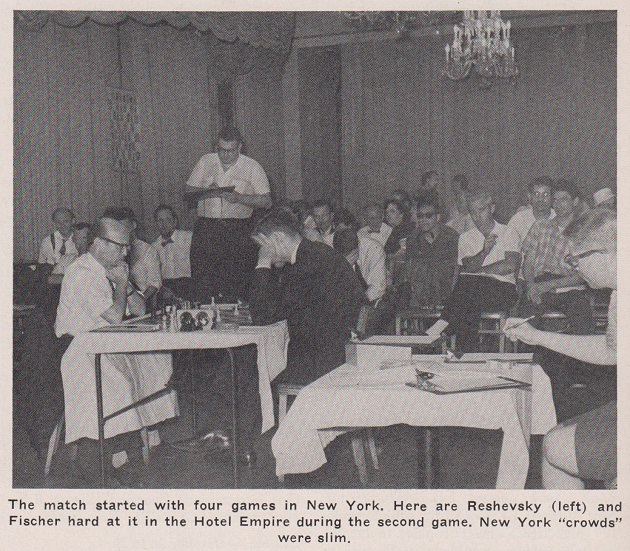
Chess Review, September 1961, page 264
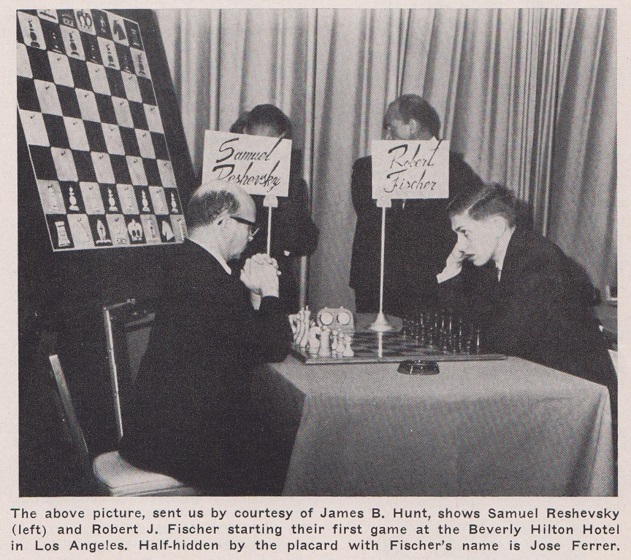
Chess Review, October 1961, page 317
Below are five press reports:
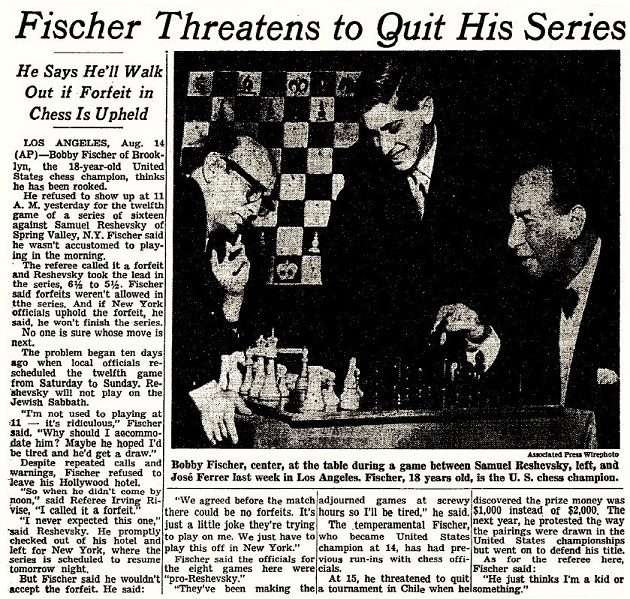
New York Times, 15 August 1961, page 36
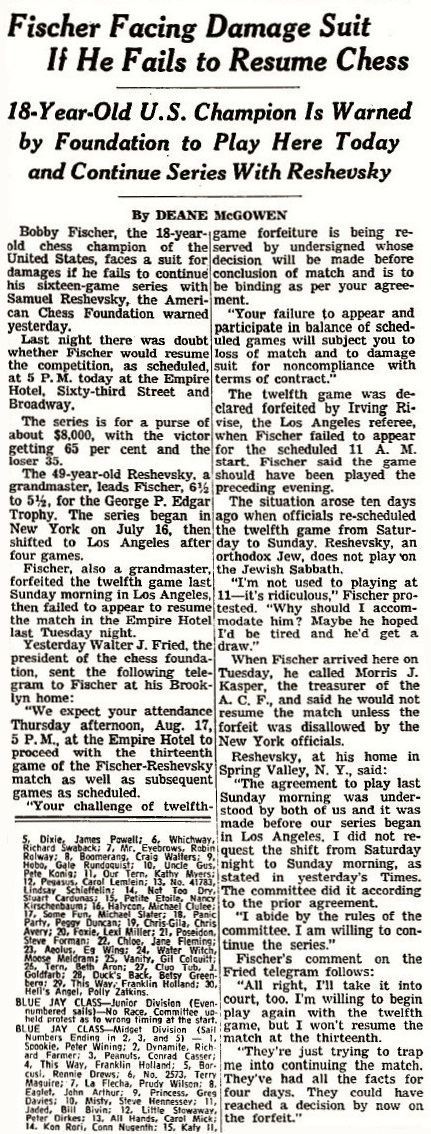
New York Times, 17 August 1961, page 22

New York Times, 18 August 1961, page 27

New York Times, 19 August 1961, page 15
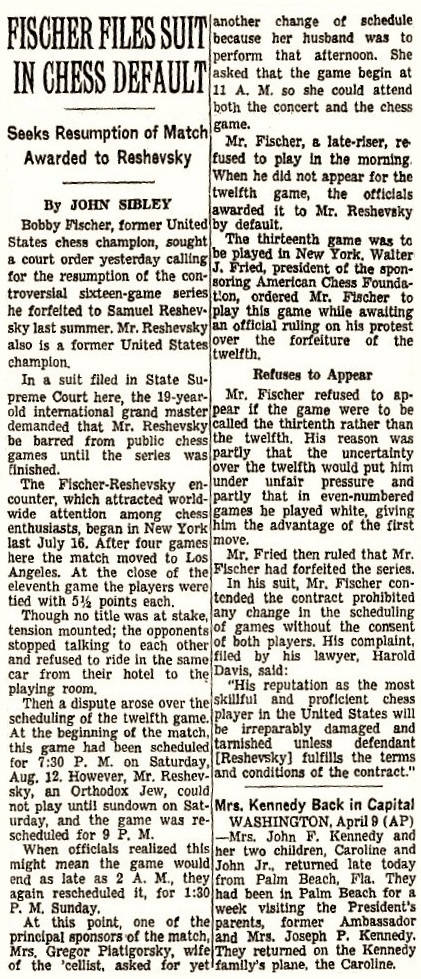
New York Times, 10 April 1962, page 33
There were briefer reports in the New York Times of 14 August 1961, page 20 and 16 August 1961, page 25. The above photograph of Reshevsky, Fischer and Ferrer in the 15 August 1961 edition is similar to the one in Chess and Hollywood. C.N. 8923 referred to coverage of the affair in Chess Life; an article entitled ‘The Fischer-Reshevsky Snafu’ on page 321 of Chess Review, November 1961 provides a notable summary.
On page 137 of Endgame (New York, 2011) Frank Brady wrote that ‘the case lingered in the courts for years and was finally dropped’. Does a detailed account of the full procedure exist?
11170. Léonard Tauber (C.N.s 7821 & 7830)
Eduardo Bauzá Mercére (New York, NY, USA) sends this game from page 38 of the Washington Post, 13 July 1919:
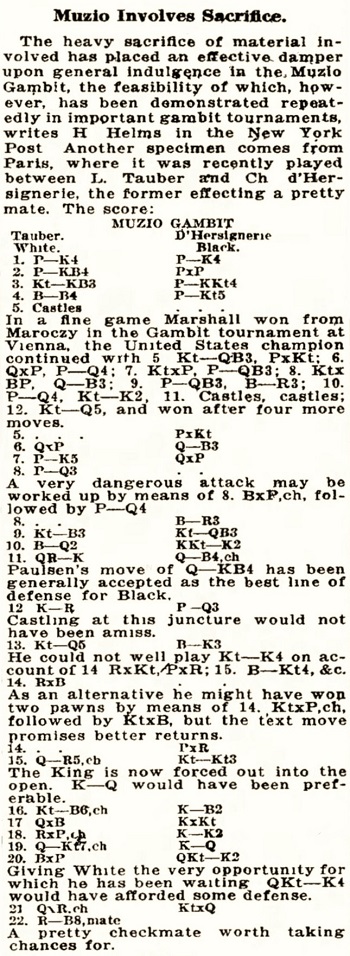
1 e4 e5 2 f4 exf4 3 Nf3 g5 4 Bc4 g4 5 O-O gxf3 6 Qxf3 Qf6 7 e5 Qxe5 8 d3 Bh6 9 Nc3 Nc6 10 Bd2 Nge7 11 Rae1 Qc5+ 12 Kh1 d6 13 Nd5 Be6 14 Rxe6 fxe6 15 Qh5+ Ng6 16 Nf6+ Kf7 17 Qxh6 Kxf6 18 Rxf4+ Ke7 19 Qg7+ Kd8 20 Bxe6 Nce7 21 Qxh8+ Nxh8 22 Rf8 mate.
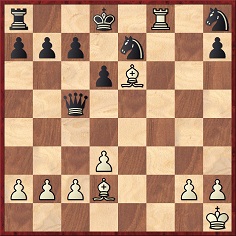
This game between Léonard Tauber and Charles d’Hersignerie had been published on pages 254-255 of La Stratégie, November-December 1918:
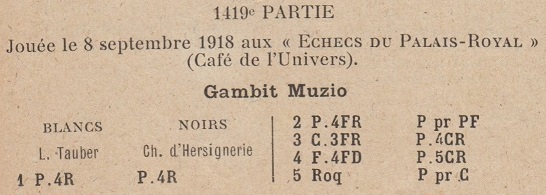
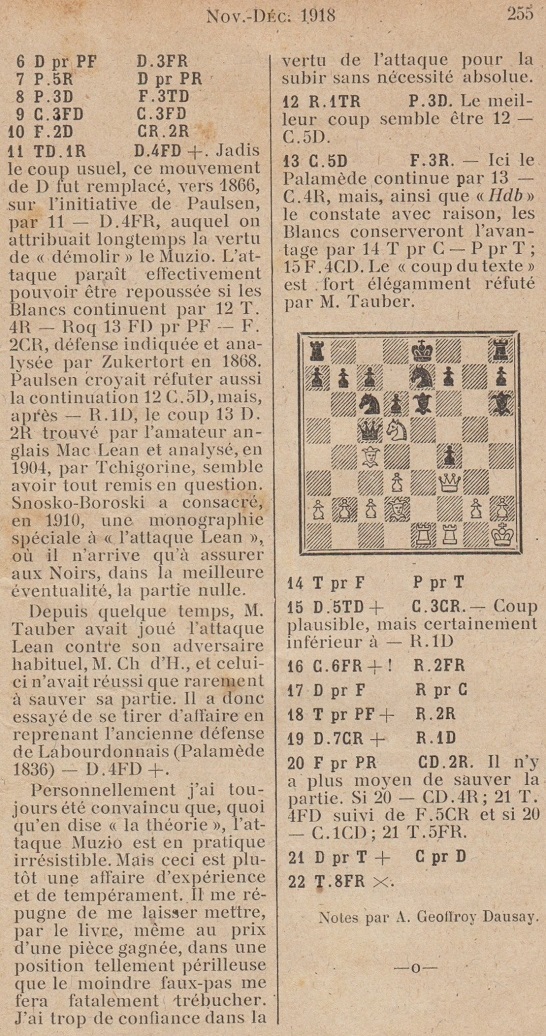
As mentioned in Chess and Jews, A. Geoffroy Dausay was a pseudonym of Alphonse Goetz.
11171. On board the Llangibby Castle
From page 184 of the June 1930 BCM:
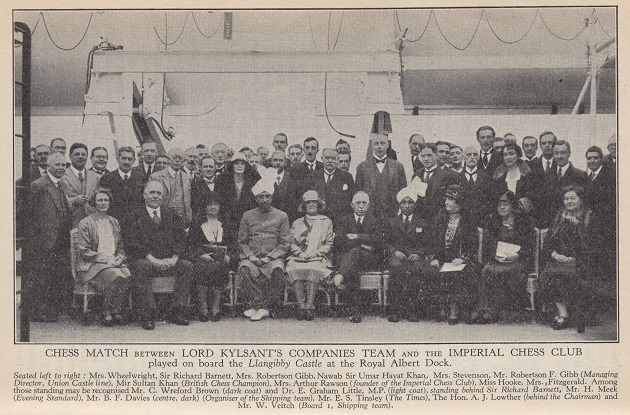
The picture has been mentioned (‘group photograph of team match, 1930’) in Sultan Khan.
11172. Intellectual gymnastics
Olimpiu G. Urcan (Singapore) has been looking into claims that Steinitz referred to chess as intellectual/mental gymnastics (geistige Gymnastik or intellektuelle Gymnastik) and offers these citations for such terms:
- Deutsche Schachzeitung, June 1866, pages 161-164 (article by V. Grimm):

- Chess Player’s Magazine, September 1866, pages 257-260 (translation of the above Grimm article):
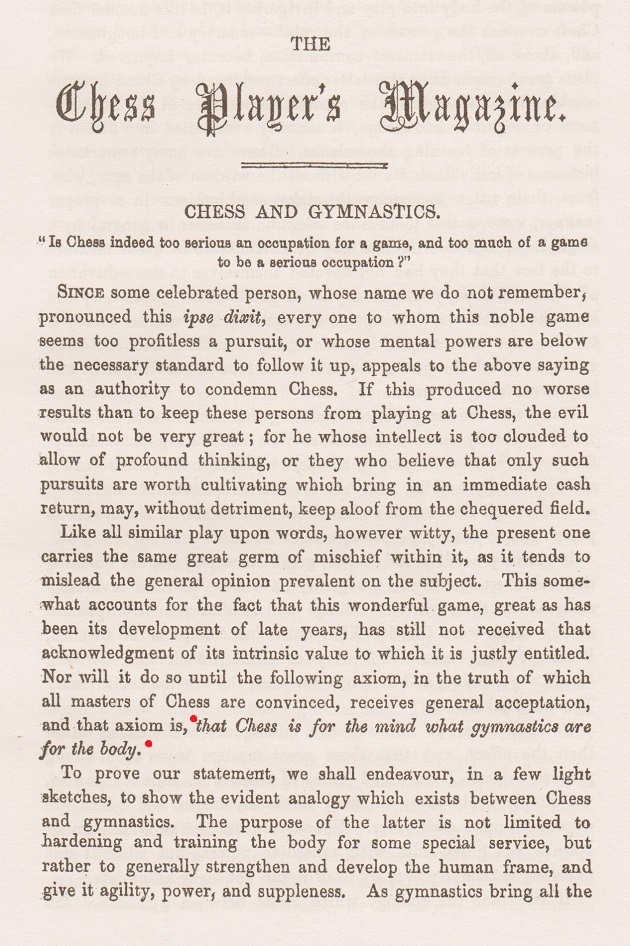
- Illustrirte Zeitung, 8 September 1866, page 162:
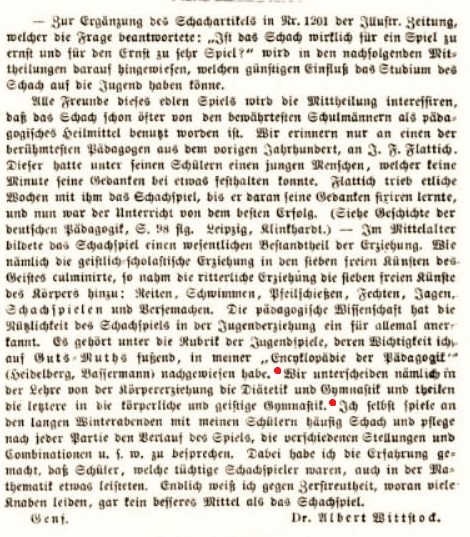
- Household Chess Magazine, 31 January 1865, page 2 (a magazine edited by Thomas Henry Hopwood):
‘It is our intention to create for our readers a series of mental recreations or, in other words, we have pleasure in presenting them with a complete
intellectual gymnastics,
on which the mental portion of their organization may take full swing.
First and foremost in our mental gymnasium stands chess, the royal game; patronized by the Emperor, who reigns over nations, and by Genius, who, still greater, reigns over minds.’
... Charades, draughts, riddles, novels of a chess character, and intellectual gymnastics generally will form additional attractions to our work, and which, we trust, will duly contribute to the amusement of our readers.’
- Wiener Presse, 14 December 1884, page 1:

- Columbia Chess Chronicle, 24 September 1887, page 107, quoting from J.A. Congdon (‘Gen. Gongdon’) in the Scranton Truth:
‘Chess is considered the most intellectual of amusements. Its tendencies are moral and refining. It is admirable mental gymnastics.’
- Letter from Steinitz to H.M. Gorham and W.E. Lester dated 13 April 1888, quoted on pages 95-96 of The Steinitz Papers by K. Landsberger (Jefferson, 2002):
‘You see I am trying to recover my good humor but I am really sincere in thinking that our mental gymnastics offered more relief to a philosophical mind in time of great affliction than even music or any other art.’
- International Chess Magazine, June 1888, pages 175-176 (in Steinitz’s ‘Personal and General’ column):
‘For many enthusiastic chessplayers are, like myself, convinced that the general cultivation of chess logic would help to cure our age from many political, economical and philosophical escrescences, and would also greatly diminish such baneful excesses and unhealthy habits as over-smoking, drinking, gambling, etc., which are incompatible with the acquisition of excellence in our mental gymnastics.’
- The Modern Chess Instructor by W. Steinitz (New York, 1889), page xxvii:
‘In our time the game is becoming more widely popular among intelligent people in different countries, and it is almost universally recognized as a healthy mental exercise, which in its effects on the intellectual faculties is akin to that of physical gymnastics on the conservation and development of bodily strength.’
- Philadelphia Inquirer, 22 October 1893, page 21 (feature by Carl Synder which included an interview with Steinitz). One of the world champion’s remarks:
‘Chess may be described as mental athletics. It is the gymnasium of the mind. I believe that the mind can be trained as easily and perfectly as the body, and I know of no better exercise than chess. It develops, strengthens and clarifies the brain.’
- Interview with Steinitz in the Pittsburg Dispatch, quoted on pages 197-198 of The Steinitz Papers by K. Landsberger (Jefferson, 2002):
‘It [chess] is a species of mental gymnastics, which, when properly applied, should be to the hygiene of the mind just what athletics are to the hygiene of the body. In other words, chessplayers may help brain workers to know how to take care of themselves.’
- Article by Steinitz in Johnson’s Universal Cyclopædia, quoted on page 151 of The Steinitz Papers by K. Landsberger (Jefferson, 2002):
‘The influence of the cultivation of this game [chess] on the highest qualities of mind bears essential resemblance to the effect of gymnastics on the growth, increase and conservation of the physical powers.’
Mr Urcan adds:
‘I cannot provide independent corroboration of the text which Landsberger states was in the Pittsburg Dispatch.
You have noted on several occasions the inadequacy of the sourcing in his book William Steinitz, Chess Champion (Jefferson, 1993), and the gymnastics matter provides another example. From page 152:
The bibliographical reference ‘(34)’ leads to nothing more precise than this on page 472:
I can at least add that pages 357-358 of the November 1885 Deutsche Schachzeitung have a reference to H. Bennecke and to Steinitz’s useful letter, but there is nothing about any “intellectual gymnastics” remark.’
11173. An unidentified figure
The photograph below was published opposite page 208 of Hundert Jahre Schachturniere by P. Feenstra Kuiper (Amsterdam, 1964). For a larger version, see C.N. 4772 and Nimzowitsch’s My System:

Concerning the ‘unknown man’ standing third from the left, Dan Scoones (Port Coquitlam, BC, Canada) writes:
‘I believe that the same individual is in the 1937 Moscow team photograph on page 210 of Chess Review, September 1937 which was reproduced in C.N. 7022. He was identified there as David:
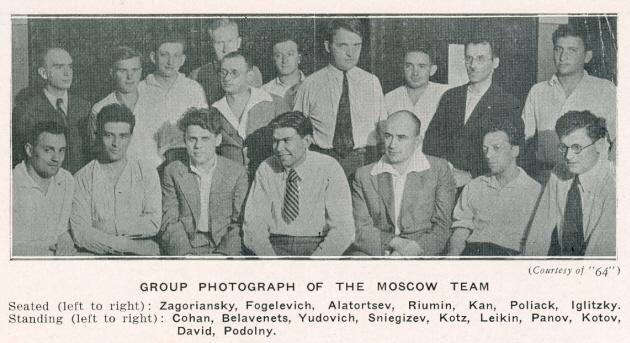
The only games of his that I have traced are from the Leningrad Semi-Final of the 11th USSR Championship, 1939, where he tied for last place with Solomon Gotthilf with 5½ points from 17 games.
There is confusion over his forename. The crosstable and game-file at the RusBase website do not agree, giving G. David and Michael David respectively. This has sown further confusion in the ChessBase database because there is a Michael David of Israel.
The Soviet player David does not seem to have had a particularly active or distinguished chess career, and his appearance in group photographs of important events is therefore rather mysterious.’
11174. Bird v Lasker
From page 101 of Lasker’s Manual of Chess (New York, 1927):

The text appears towards the end of the Second Book; page numbers vary in other editions.
Jean-Pierre Rhéaume (Montreal, Canada) points out that the game in question which began 1 f4 e5 2 fxe5 d6 3 exd6 Bxd6 4 Nf3 g5 occurred in the second Lasker v Bird match, i.e. in 1892 and not 1890.
The score was given on pages 485-486 of H.E. Bird by Hans Renette (Jefferson, 2016), with these notes by Steinitz from page 22 of the New York Daily Tribune, 25 September 1892:

Notwithstanding what appears in some publications and databases, the game continued until move 63, as reported in many contemporary sources, such as page 5 of The Scotsman, 31 August 1892 and page 12 of Lasker’s London Chess Fortnightly, 1 September 1892. The concluding moves (after 42...Bxh1) have not been found.
Page 68 of the recent Zenón Franco book on Lasker (C.N.s 11130, 11139 and 11140) has ‘40 Bb6 Bd5! 0-1’. As regards the opening, page 61 states:

The misspelling ‘Fromm’ is common, but the player’s name is not in doubt: Martin From (1828-95).
Some articles on the opening:
- ‘Zur Eröffnung 1 f2-f4. From’s Gambit’ by S.A. Sörensen, Deutsche Schachzeitung, July-August 1862, pages 200-202;
- ‘From’s Gambit’ by J.H. Zukertort, Chess Monthly, October 1879, page 54; December 1879, pages 110-111; January 1880, pages 141-144; March 1880, pages 213-215; April 1880, pages 246-248;
- ‘From’s Gambit’ by C. von Bardeleben, Deutsche Schachzeitung, July 1919, pages 132-137.
11175. Opposite-coloured bishops
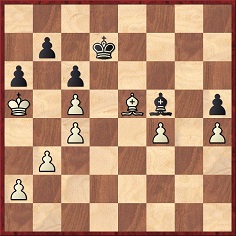
White to move
This position was analyzed by Emanuel Lasker. Can White win?
11176. Modern chess and the good old days
The start of an article entitled ‘Modern Chess Dull?!’ by Fred Reinfeld on page 32 of the Chess Review, March 1940:
‘It is unfortunate, but true, that a sizable proportion of amateurs find modern master chess dull. “Ah, the good old days!” This is based on what is for the most part an imaginary kind of chess which is supposed to have been peculiar to any age but our own. If the good old chess was really so interesting, we should expect it to have flourished in the first International Tournament, held at London in 1851. If we turn to the Book of the Tournament, however, we discover that it is an epochal collection of the most dreary, tedious, witless, planless, slovenly and inept chess that has ever been assembled between the covers of a book. Of the 85 games in the main event, not more than five could be described as brilliant by the most charitable man in the world; and he would be hard put to it to find ten games that were worth looking at.
It is impossible to retain any more illusions about the chess of this period as one reads Staunton’s peppery philippics against his bumble-fingered colleagues. (And since he was much inferior to present-day analysts, he leaves myriads of blunders untouched!)’
Reproducing the article, until the title ‘Ah, The Good Old Days!’, on pages 96-98 of his anthology The Treasury of Chess Lore (New York, 1951), Reinfeld added this introduction:
‘At the time I wrote this article I was nettled by the disparagement of modern masters which flourishes side by side with unthinking praise for the ancients. My views are still the same, although my approach to his [sic] type of controversy has mellowed considerably!’
‘The Good Old Days’ was the heading to game 46 (Flohr v Landau, Antwerp, 1930) on page 91 of Chess Strategy and Tactics by Fred Reinfeld and Irving Chernev (New York, 1933):
‘In every chess era the greybeards are forever bemoaning, maliciously or mournfully, the passing of “the good old days”. Nowadays, for example, one hears that there is no “brilliancy” left in chess, no sacrifices, no combinations. There is nothing left, runs the wail, but stodgy woodshifting. For those who still look back sadly to the flashy and trashy confetti of so-called “immortal games”, we offer a bit of consolation ...’
On page 181 of Great Brilliancy Prize Games of the Chess Masters (New York, 1961) Reinfeld introduced Flohr v Landau as follows:
‘Many years ago, when I first saw this game, it seemed to me an effective refutation of the charge that modern chess is much less brilliant than the old-time variety. Now that so many years have passed, this game is no longer “modern”, but it is still a delight to play over and appreciate.’
1 d4 Nf6 2 c4 c6 3 Nf3 d5 4 e3 e6 5 Nbd2 Be7 6 Bd3 Nbd7 7 O-O O-O 8 b3 c5 9 Bb2 cxd4 10 exd4 dxc4 11 bxc4 b6 12 Qc2 Bb7 13 Ne5 Qc7 14 f4 Rfd8 15 Ndf3 h6 16 Qe2 Nxe5 17 fxe5 Nd7 18 d5 Bc5+ 19 Kh1 exd5
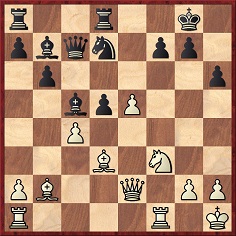
20 Ng5 Nf8 21 Nxf7 Re8 22 Qg4 Re6 23 Bf5 Rae8 24 Bxe6 Rxe6 25 Nd6 Bxd6 26 exd6 Qd7 27 Ba3 Nh7 28 h3 dxc4 29 Qxc4 Nf6 30 Rxf6 gxf6 31 Re1 Bc8 32 Rc1 Bb7 33 Qg4+ Kh8 34 Rc7 Re1+ 35 Kh2 Qxg4 36 hxg4 Resigns.
From page 627 of L’Echiquier, 12 February 1930:
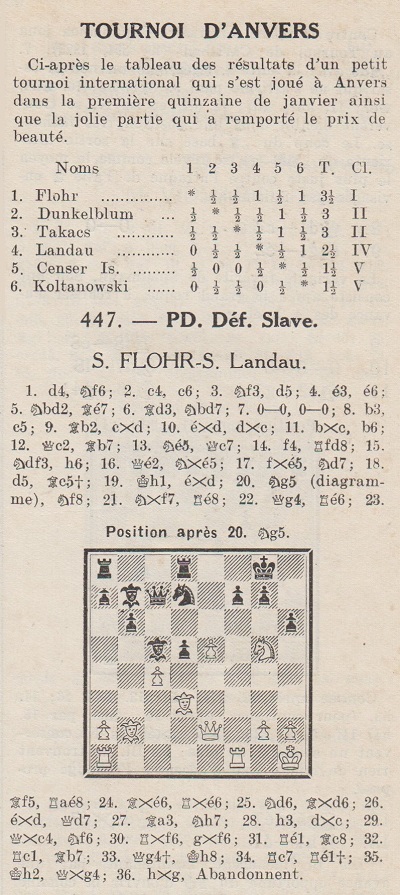
Flohr annotated his victory on pages 46-47 of Československý Šach, March 1930:
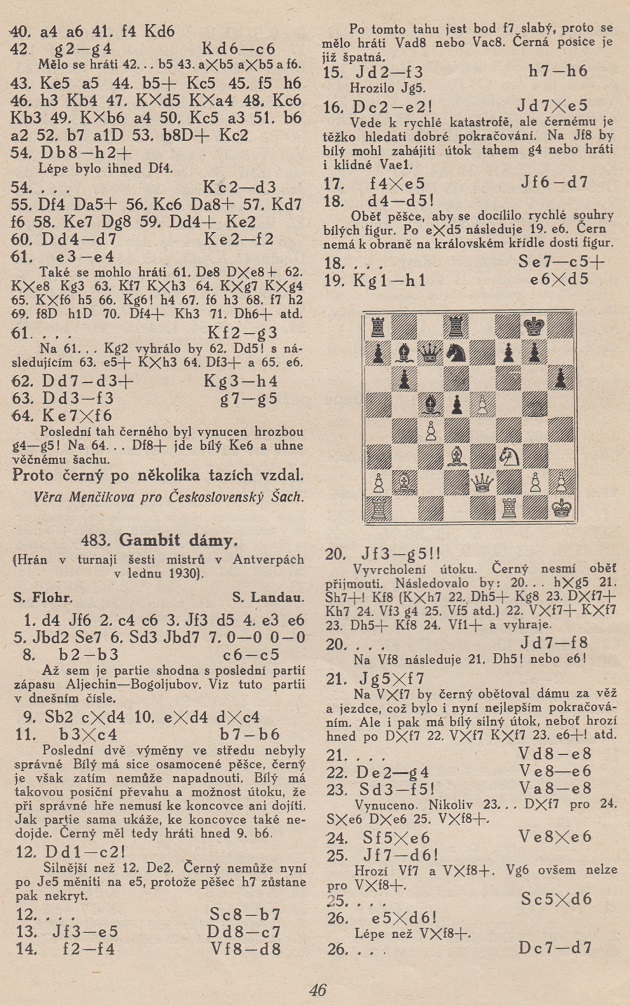

11177. Alekhine v Alexander
‘Some of Marshall’s most sparkling moves look at first like typographical errors.’
This well-known remark is listed in The Chess Wit and Wisdom of W.E. Napier.
On page 194 of Great Brilliancy Prize Games of the Chess Masters (New York, 1961) Fred Reinfeld wrote:
‘Some of Alekhine’s best combinations are so startlingly original that they give the impression of being oversights. In this regard, 20 P-K4! is one of his most striking moves.’
The game was Alekhine v Alexander, Nottingham, 1936:
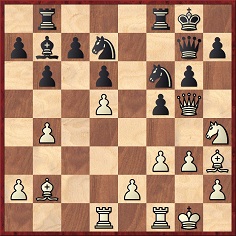
On page 196 Reinfeld commented regarding 20 e4:
‘This sly move looks like a blunder, as Black can now win a pawn.’
The game continued 20...Nxe4 21 Qc1 Nef6 22 Bxf5, and Black resigned at move 27.
11178. ‘The Immortal Lightning Game’
From pages 306-307 of The Delights of Chess by Assiac (New York, 1974):


Assiac had also presented the conclusion on page 202 of Chess Treasury of the Air by Terence Tiller (Harmondsworth, 1966):
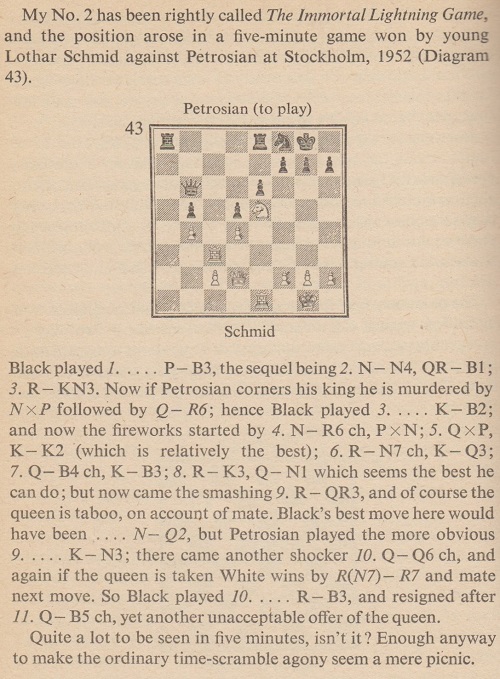
1 e4 c6 2 Nc3 d6 3 d4 Nf6 4 Bf4 Qb6 5 Qd2 Nbd7 6 Nf3 e6 7 Bd3 Be7 8 O-O O-O 9 a4 Qc7 10 e5 Nd5 11 Nxd5 cxd5 12 Rae1 Re8 13 Re3 Nf8 14 Rfe1 Bd7 15 a5 a6 16 exd6 Bxd6 17 Bxd6 Qxd6 18 Ne5 Bb5 19 Bxb5 axb5 20 b4 b6 21 axb6 Qxb6 22 Rc3 f6 23 Ng4 Rac8 24 Rg3 Kf7 25 Nh6+ gxh6 26 Qxh6 Ke7 27 Rg7+ Kd6 28 Qf4+ Kc6 29 Re3 Qb8 30 Ra3 Kb6 31 Qd6+ Rc6 32 Qc5+ Resigns.
The full score of this allegedly ‘celebrated’ game is in databases, but which is the earliest, or best, primary source?
11179. Lasker on development
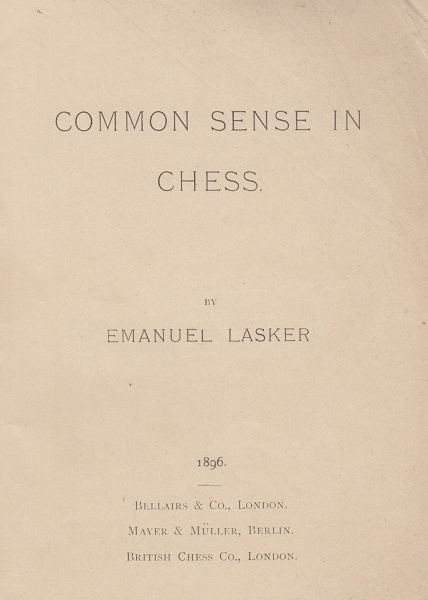
Pages 60-61 of Common Sense in Chess by Emanuel Lasker (London, 1896):
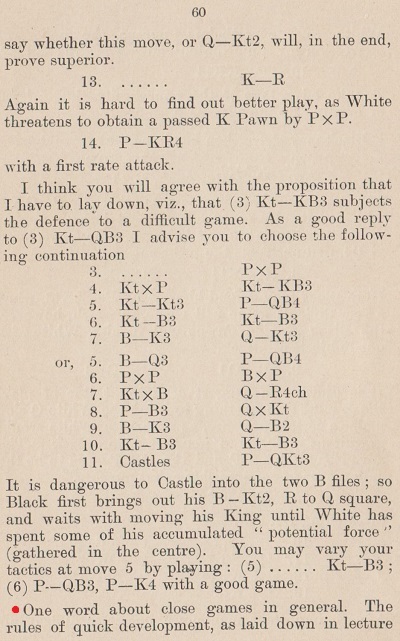
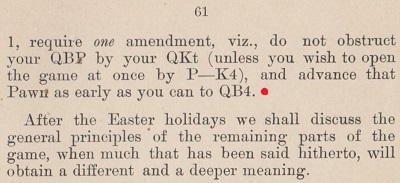
On page 36 of Chess Treasury of the Air by Terence Tiller (Harmondsworth, 1966) Harry Golombek quoted the marked paragraph and contended:
‘This sentence alone contains more instruction than many a book that we see turned out by the dozen nowadays.’
11180. Chigorin engraving (C.N. 5686)
Another version of the engraving of Chigorin playing blindfold, published on page 444 of the 23 April 1888 edition of Niva:

11181. Johannes Metger (C.N. 11141)
The full obituary of Metger on pages 199-201 of Kagans Neueste Schachnachrichten, January-March 1926:
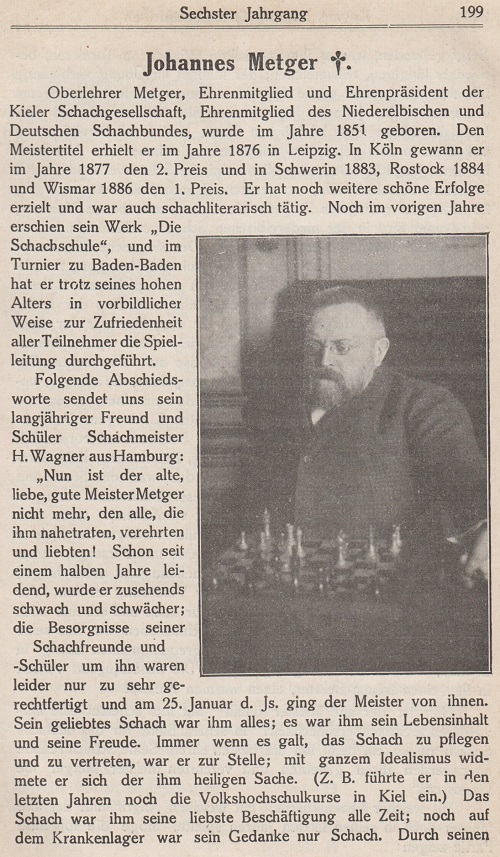
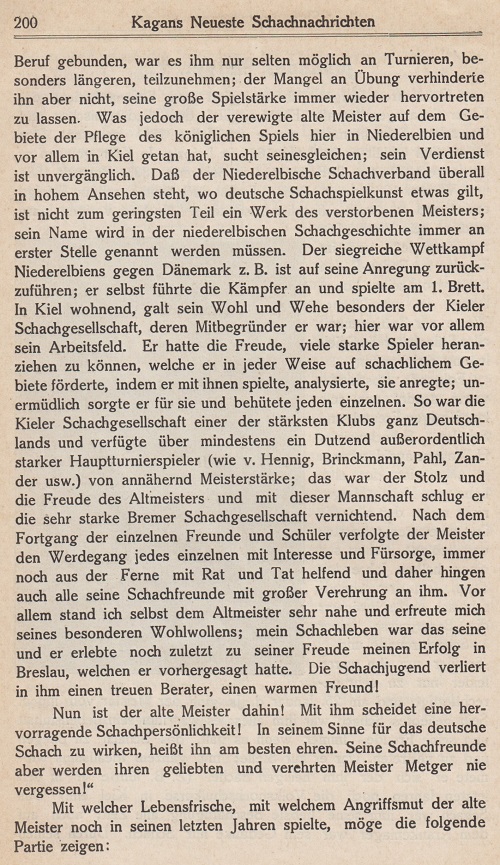
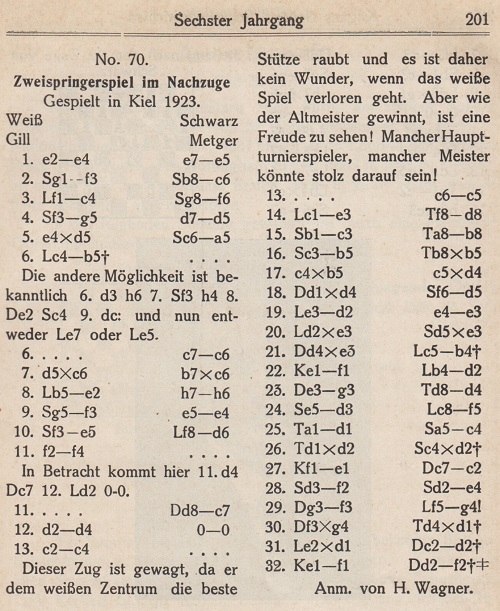
The end of the Gill v Metger game-score is garbled, and we have added 30...Qc1+: 1 e4 e5 2 Nf3 Nc6 3 Bc4 Nf6 4 Ng5 d5 5 exd5 Na5 6 Bb5+ c6 7 dxc6 bxc6 8 Be2 h6 9 Nf3 e4 10 Ne5 Bd6 11 f4 Qc7 12 d4 O-O 13 c4 c5 14 Be3 Rd8 15 Nc3 Rb8 16 Nb5 Rxb5 17 cxb5 cxd4 18 Qxd4 Nd5 19 Bd2

19... e3 20 Bxe3 Nxe3 21 Qxe3 Bb4+ 22 Kf1 Bd2 23 Qg3 Rd4 24 Nd3 Bf5 25 Rd1 Nc4 26 Rxd2 Nxd2+ 27 Ke1 Qc2 28 Nf2 Ne4 29 Qf3 Bg4 30 Qxg4 Qc1+ 31 Nd1 Rxd1+ 32 Bxd1 Qd2+ 33 Kf1 Qf2 mate.
11182. ‘The Immortal Lightning Game’ (C.N. 11178)
Hans-Georg Kleinhenz (Munich, Germany) sends a report by Lothar Schmid on pages 382-383 of Caissa (‘2. Oktober-Heft 1952’):
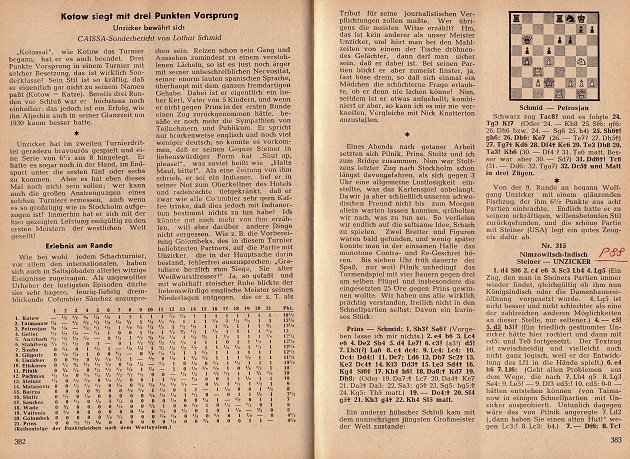
11183. Meyer v Hirschfeld
Hans Renette (Bierbeek, Belgium) and Fabrizio Zavatarelli (Milan, Italy) provide two games between H.F.L. Meyer and P. Hirschfeld which are not in their book Neumann, Hirschfeld and Suhle (Jefferson, 2018).
11184. De mortuis
Wanted: examples of particularly negative chess obituaries, whatever the level of justification.
Norman T. Whitaker, one of the game’s leading reprobates, received little attention when he died in 1975. The obituary by his colleague James E. Gates on page 521 of the August 1975 Chess Life & Review was low-key:
‘Outside chess Norman was not very distinguished, being involved in too many things at and beyond the laws he studied.’
11185. Opposite-coloured bishops (C.N. 11175)
From pages 102-103 of Schachjahrbuch 1922 by Ludwig Bachmann (Ansbach, 1924):


11186. Barry Martin on chess history
Based on a very short browse, below are some extracts from Chess Problems, Play and Personalities by Barry Martin (Beddington, 2018).
The start of an article about Alekhine on pages 41-43:
‘... his father was a landowner, a Marshal of Nobility, and a member of the Russian Duma. His mother was an heiress to an industrial fortune. Alekhine became addicted to the game of chess at the age of 11 ...’
This brings to mind page 5 of The Oxford Companion to Chess by D. Hooper and K. Whyld (Oxford, 1984):
‘His father was a landowner, a Marshal of Nobility, and a member of the Duma, his mother heiress of an industrial fortune. ... Alexander became addicted to the game at the age of about 11 ...’
Similarly, pages 194-195 (the section on Leonard Barden) are little more than pickings from his Wikipedia entry.
Sometimes, though, Mr Martin is self-reliant. From page 70:
‘Howard Staunton, the only English chess player ever to have held the title of World Champion by winning against the generally accepted World Champion, St. Amain in Paris in 1843 ...’
Page 81 discusses St Petersburg, 1914:
‘The combatants in the main tournament were the leading lights at that time of world chess, five of whom had played in a pre-tournament which included 11 players to the main tournament in St Petersburg.’
Page 269 states that Capablanca ...
‘... taught himself the game of chess at the age of 13’.
11187. Hutagalung and Purdy
From page 35 of the February 1961 Chess Review:

11188. Opposite-coloured bishops (C.N.s 11175 & 11185)

White to move
This position from a game between A. van Foreest and H. Wagner in an international team match was analyzed by Emanuel Lasker as a win for White.
W. John discussed the match on pages 121-123 of the June 1922 Deutsche Schachzeitung, with, at the bottom of page 122, a reference to Lasker’s analytical work:
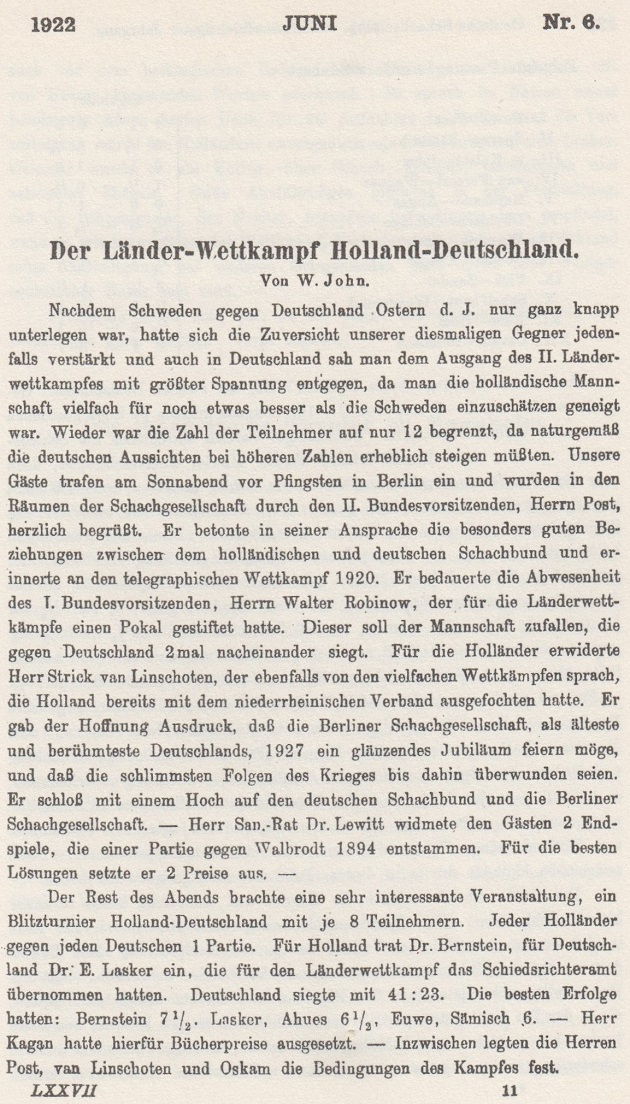

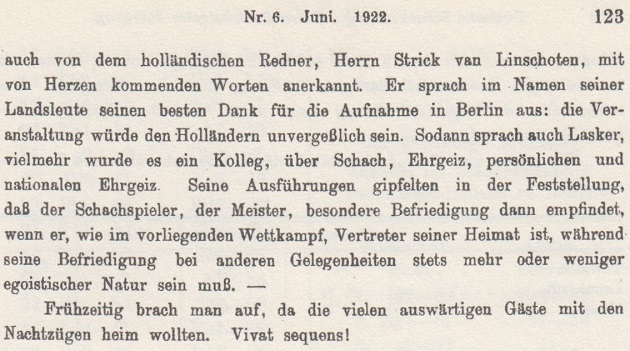
The Deutsche Schachzeitung did not give the game-score, but it was published on pages 127-128 of Deutsches Wochenschach, 18 June 1922:

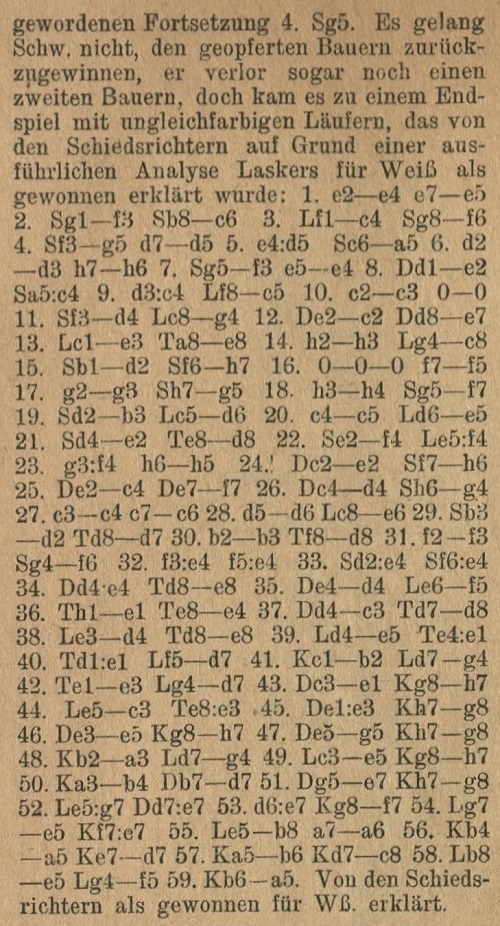
The game is also on pages 151-152 of the June 1922 Tijdschrift van den Nederlandschen Schaakbond, with a reference to analysis by Bernstein as well as Lasker:
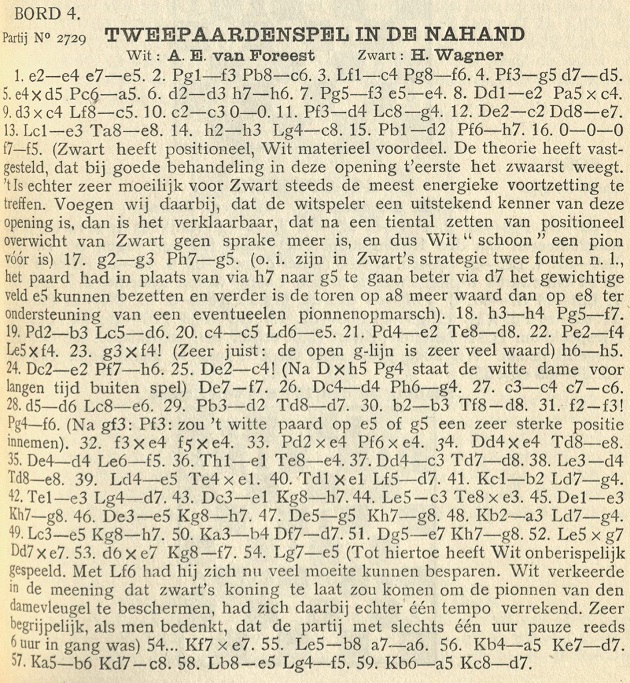
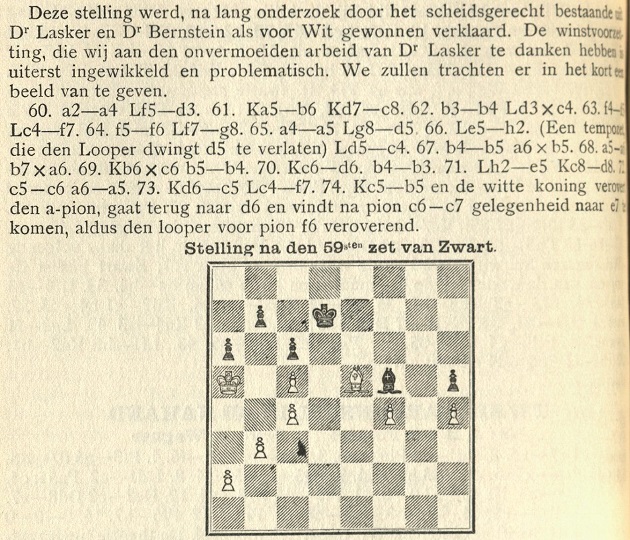
The pages from Deutsches Wochenschach and Tijdschrift van den Nederlandschen Schaakbond are reproduced courtesy of the Cleveland Public Library.
The full game: 1 e4 e5 2 Nf3 Nc6 3 Bc4 Nf6 4 Ng5 d5 5 exd5 Na5 6 d3 h6 7 Nf3 e4 8 Qe2 Nxc4 9 dxc4 Bc5 10 c3 O-O 11 Nd4 Bg4 12 Qc2 Qe7 13 Be3 Rae8 14 h3 Bc8 15 Nd2 Nh7 16 O-O-O f5 17 g3 Ng5 18 h4 Nf7 19 N2b3 Bd6 20 c5 Be5 21 Ne2 Rd8 22 Nf4 Bxf4 23 gxf4 h5 24 Qe2 Nh6 25 Qc4 Qf7 26 Qd4 Ng4 27 c4 c6 28 d6 Be6 29 Nd2 Rd7 30 b3 Rfd8 31 f3 Nf6 32 fxe4 fxe4 33 Nxe4 Nxe4 34 Qxe4 Re8 35 Qd4 Bf5 36 Rhe1 Re4 37 Qc3 Rd8 38 Bd4 Rde8 39 Be5 Rxe1 40 Rxe1 Bd7 41 Kb2 Bg4 42 Re3 Bd7 43 Qe1 Kh7 44 Bc3 Rxe3 45 Qxe3 Kg8 46 Qe5 Kh7 47 Qg5 Kg8 48 Ka3 Bg4 49 Be5 Kh7 50 Kb4 Qd7 51 Qe7 Kg8 52 Bxg7 Qxe7 53 dxe7 Kf7 54 Be5 Kxe7 55 Bb8 a6 56 Ka5 Kd7 57 Kb6 Kc8 58 Be5 Bf5 59 Ka5 Kd7. Adjudicated a win for White.
For ease of reference, the feature on pages 102-103 of L. Bachmann’s Schachjahrbuch 1922 (C.N. 11175) is repeated here:


Richard Forster (Zurich) writes:
‘The analysis in the Schachjahrbuch and in the Dutch magazine differ, and it is possible that Lasker gave no concrete lines himself, but showed the general winning plan, which different editors then put into different lines. Although both sets of analysis lead to a win, the best result comes from combining the two.
60 Kb6 Kc8 61 b4 Bd3 62 a4 Bxc4 63 f5 Bg8 64 f6 Be6 65 a5! Bd5
66 Bh2!
66 b5 axb5 leads nowhere, but now Black is in Zugzwang. After the move in the Schachjahrbuch (66 Ba1), Black could defend more tenaciously with 66...Kb8, forcing White to go for the Zugzwang with, for instance, 67 Bb2 Kc8 68 Be5.
66...Bc4 67 b5! axb5
67...cxb5 68 c6 bxc6 69 Kxa6 c5 70 Kb6 also wins for White. The try 67...Kd7!? 68 bxc6+ bxc6 leads to a technically lost position after 69 f7 Ke7 70 Kxc6 Bxf7 71 Kb6 Kd7 72 c6+! (but not 72 Kxa6?? Kc6).
68 a6 bxa6 69 Kxc6 b4 70 Kd6!
White does not need the king manoeuvre to b6 or b5 (which is given in both sets of analysis, although at different points). Against the best defence, this would simply lose time. The king belongs on d6.
70...b3 71 Be5 Kd8 72 c6 a5 73 c7+ Kc8 74 Bb2 a4
75 Ba3!
The important last point. If White cashes in too early with 75 Ke7? Kxc7 76 f7 Bxf7 77 Kxf7, Black has 77...Kd6! and saves the game.
75...Bg8 76 Ke7 Kxc7 77 f7 Bxf7 78 Kxf7 Kc6
Thanks to 75 Ba3, Black does not have the square d6 for the king and must lose.
79 Ke6
White wins by picking up the queen’s-side pawns with his king.’
11189. Chess bibles
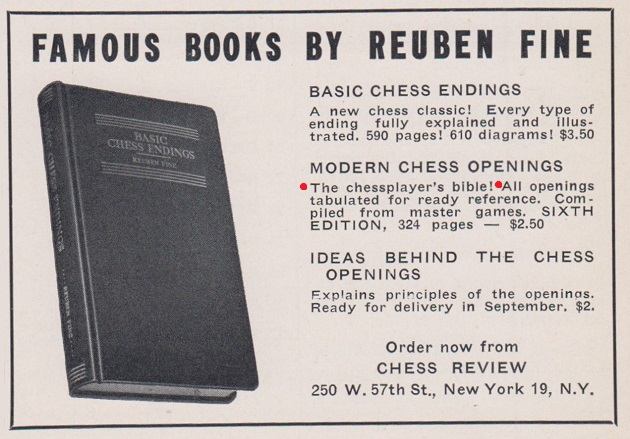
Chess Review, August-September 1943, page 243
A remark by Adam Hart-Davis in a tribute to Irving Chernev on page 278 of CHESS, December 1981:
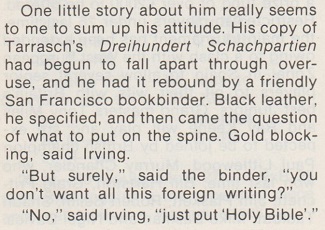
Adam Hart-Davis also related the story on page 8 of 200 Brilliant Endgames by Irving Chernev (New York, 1989):
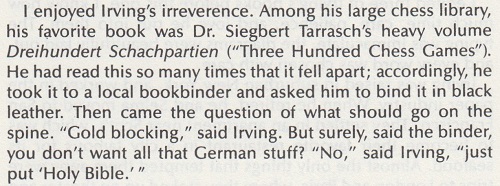
11190. V.P. v A. Aurbach
Page 89 of La Stratégie, April 1922:

1 e4 e5 2 f4 exf4 3 Nf3 Nf6 4 e5 Nh5 5 d4 d5 6 Be2 Rg8 7 O-O g5 8 h3 Ng3 9 Re1 Be6 10 Nh2 h5 11 Bxh5 Nc6 12 c3 Qd7 13 Bg4 O-O-O 14 Bxe6 fxe6 15 Ng4 Rh8 16 Nf6 Qg7 17 Qg4 Nf5 18 Nd2 Rh4 19 Qe2 Ng3 20 Qd1 Nxe5 21 dxe5 g4 22 Nxg4 Rxg4 23 Nf3 Bc5+ 24 Nd4 Rh4 25 Kh2 Rxh3+ 26 gxh3 Nf1+ 27 Kh1 Qg3 28 Bxf4 Qxh3+ 29 Kg1 Rg8+ 30 Kf2 Rg2+ (30...Qg2 mate.) 31 Kxf1 Qh1 mate.
11191. Unsound combinations
Taking the example of a 1932 Spielmann v Stoltz game, C.N. 2035 (see pages 208-209 of Kings, Commoners and Knaves) asked whether the definition of ‘combination’ should cover combinative hallucinations.
Not according to Emanuel Lasker, who wrote on page 153 of Lasker’s Manual of Chess (New York, 1927):
‘A combination must be sound. An unsound combination is no combination at all. It is merely an attempt, an error, a failure, a nonentity.’
The remark is in the Third Book, after a Tartakower-Alekhine position. The text in various German editions (page numbers vary):
‘Eine Kombination muß richtig sein, sonst ist sie nur ein Versuch, ein Fehlgriff, ein Irrtum, und eigentlich ein Unding.’
11192. Pilnik v Najdorf
‘It would not be too much of an exaggeration to say that this game is one long combination. This is really a way of paying tribute to White’s inexhaustible ingenuity in conjuring up new attacking ideas.’
That was Fred Reinfeld’s introduction to Pilnik v Najdorf, Mar del Plata, 24 March 1942 on page 202 of Great Brilliancy Prize Games of the Chess Masters (New York, 1961).
Below is an early appearance of the game, on page 76 of the May 1942 issue of the Argentinian chess and bridge magazine Estrategia (whose four photographs of the tournament were given in C.N. 9933):
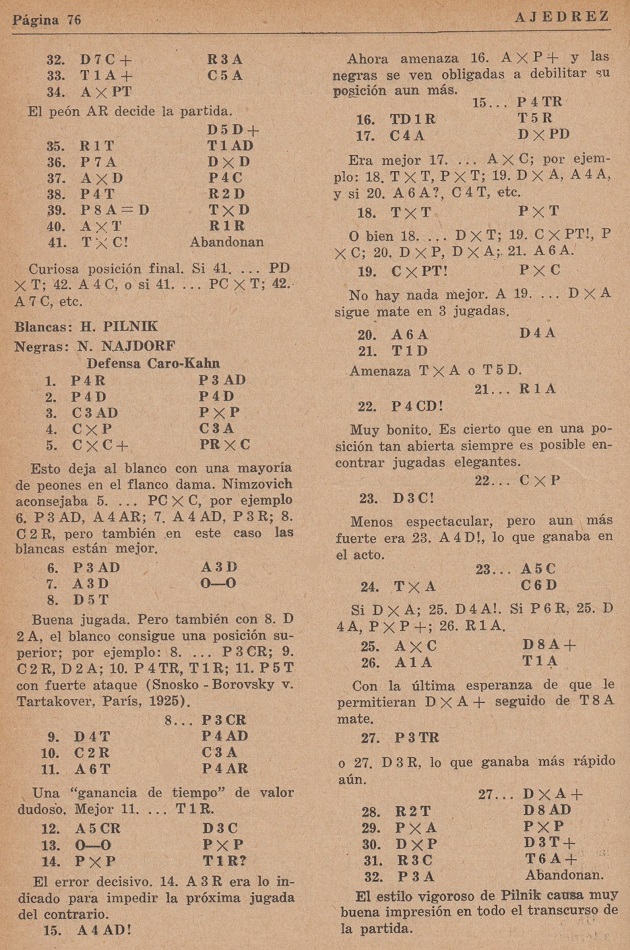
1 e4 c6 2 d4 d5 3 Nc3 dxe4 4 Nxe4 Nf6 5 Nxf6+ exf6 6 c3 Bd6 7 Bd3 O-O 8 Qh5 g6 9 Qh4 c5 10 Ne2 Nc6 11 Bh6 f5 12 Bg5 Qb6 13 O-O cxd4 14 cxd4 Re8 15 Bc4 h5 16 Rae1 Re4 17 Nf4 Qxd4 18 Rxe4 fxe4 19 Nxh5 gxh5 20 Bf6 Qc5 21 Rd1 Kf8 22 b4 Nxb4 23 Qg3 Bg4 24 Rxd6 Nd3 25 Bxd3 Qc1+ 26 Bf1 Rc8 27 h3 Qxf1+ 28 Kh2 Qc1 29 hxg4 hxg4 30 Qxg4 Qh6+ 31 Kg3 Rc3+ 32 f3 Resigns.
‘A fascinating game, beautifully handled by White from start to finish’, wrote Reuben Fine on pages 137-138 of the June-July 1942 Chess Review. His article, reproduced on pages 198-201 of Chess Marches On! (New York, 1945), was liberal with exclamation marks, and in one note a possible move for White surprisingly received four:
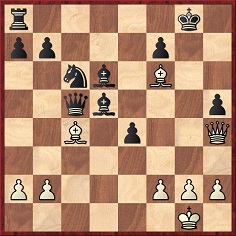
Position after 22 Rd1-d5 Be6xd5
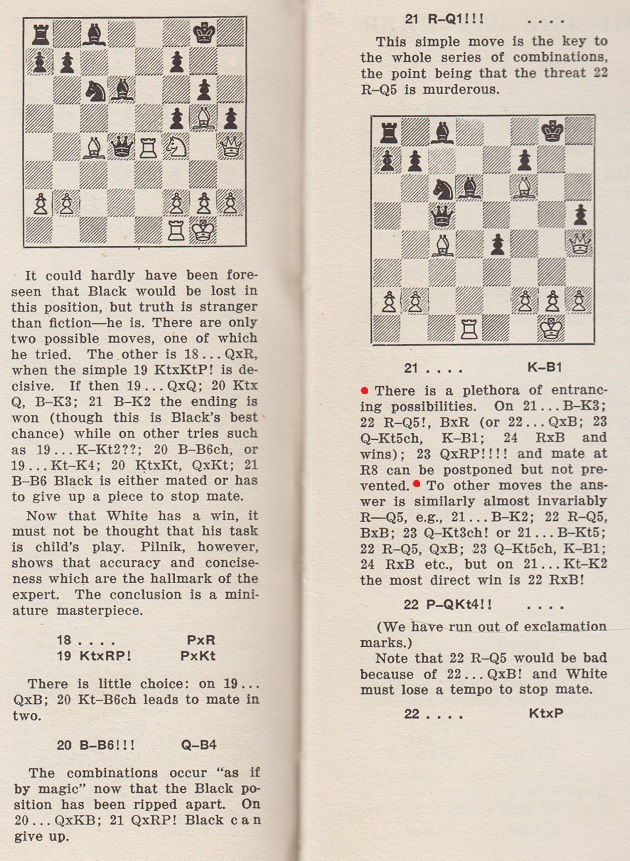
The game was also annotated on pages 122-126 of The Art of Attack in Chess by V. Vuković (Oxford, 1965). See too pages 116-120 of the algebraic edition edited by John Nunn (London, 1998).
11193. Alekhine v Capablanca
The recent death of Stephen Berry brings to mind his clever contribution to a C.N. topic 25 years ago. (See pages 316-317 of Kings, Commoners and Knaves.)
C.N. 1973 showed this position on pages 63-64 of Turnierpraxis by Franz Gutmayer (Berlin and Leipzig, 1922):
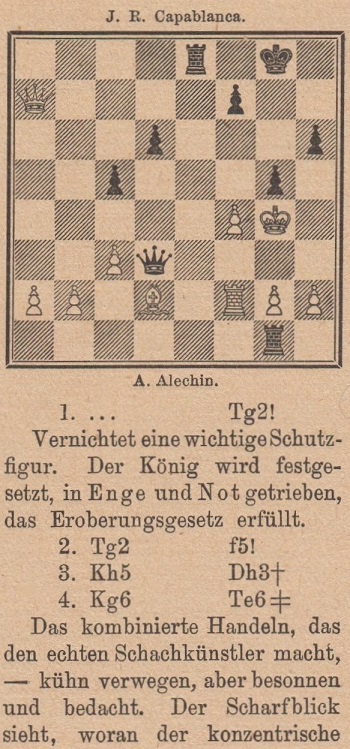

In C.N. 1988 Jan Kalendovský (Brno, Czech Republic) noted the following on page 65 of Tarrasch’s book on St Petersburg, 1914, in the sixth-round game between the two future world champions:
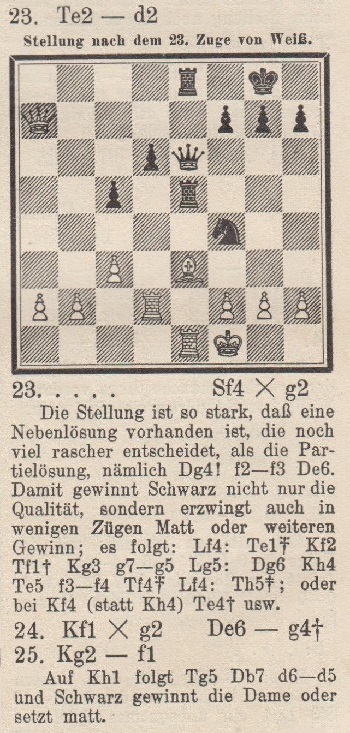
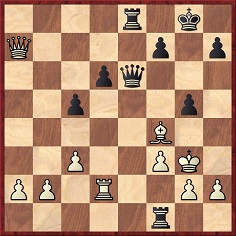
Position after 27...g5 in the above variation by Tarrasch
Mr Kalendovský commented that the above position broadly resembled the one in Gutmayer’s book.
Further to the Tarrasch analysis, C.N. 2003 reported:
Stephen Berry (London) has ingeniously concocted a variation (after 23...Qg4 24 f3 Qe6 25 Bxf4 Rxe1+ 26 Kf2) which results in Gutmayer’s position:
26...Rg1 (threat: 27...Qe1 mate) 27 Kg3 h6 28 Rf2 (28 Rxd6 Qe2) 28...g5 29 Bd2 Qc4 (intending 30...Qh4 mate) 30 f4 Qd3+ 31 Kg4.

For further discussion of the matter, see C.N. 3300 on pages 292-293 of Chess Facts and Fables. In particular, Peter Anderberg (Harmstorf, Germany) noted that the line created by Stephen Berry was pointed out by C. Sander on page 170 of the June 1914 Deutsche Schachzeitung.
11194. Mastery
‘Ei ole ju keegi loodud meistriks, vaid tee selle saavutamiseni kulgeb pikaaegse ōppimise, vōistlemise, rōōmude ja murede kaudu.’
That remark by Paul Keres on page 9 of his book Valitud partiid 1931-1958 (Tallinn, 1961) is best known from the English edition. From page v of Grandmaster of Chess. The Early Games of Paul Keres translated and edited by Harry Golombek (London, 1964):
‘Nobody is born a master. The way to mastery leads to the desired-for goal only after long years of learning, of struggle, of rejoicing and of disappointment.’
The remark was in large letters at the top of page 805 of the December 1975 Chess Life & Review, in a tribute to Keres which claimed to show the last photograph of him (with Euwe in Amsterdam on 31 May 1975). On the Internet the quote is customarily, if not exclusively, found with ‘desired’, and not ‘desired-for’. That shorter version is on page 5 of John Nunn’s edition of the book, Paul Keres: The Road to the Top (London, 1996).
11195. Lasker in fiction
Bob van de Velde (Amsterdam) draws attention to a passage about Emanuel Lasker in the 2010 novel Field Grey by Philip Kerr. Page numbers vary from one edition to another, but the text is at the start of the chapter entitled ‘Berlin, 1954’:
‘Most people go through life accumulating possessions. I seemed to have gone through mine losing them or having them taken away from me. The only thing I still had from before the war was a broken chess piece made of bone – the head of a black knight from a Selenus chess set. During the last days of the Weimar Republic this black knight had been constantly in use at the Romanisches Café, where, once or twice, I’d played the great Emmanuel [sic] Lasker. He’d been a regular at the café until the Nazis obliged him and his brother [sic – Berthold Lasker died in 1928] to leave Germany for ever, in 1933. I could still picture him crouched over a board with his cigarettes and cigars and his Wild West moustache. Generous to a fault, he would give out tips or play exhibitions for anyone who was interested; and on his last day in the Romanisches Cafe – he went to Moscow, and then to New York – Lasker presented everyone who was there to wish him goodbye with a chess piece from the café’s best set. I got the black knight. The way I’d been played over the years I sometimes think a black pawn would have been more appropriate. Then again, a knight, even a broken one, seems intrinsically more valuable than a pawn, which was probably why I tried so hard to keep it through one adversity after another.’
11196. The number of chessplayers (C.N. 11147)
More figures advanced in Lasker’s Manual of Chess (New York, 1927), page 369:
‘In fact, there are a quarter of a million chess friends who devote to chess at least two hundred hours every year, and of these only a thousand, after a lifetime of study, attain the end. Without losing myself in calculations, I believe I am safe in voicing the opinion that our efforts in chess attain only a hundredth of one per cent of their rightful result.’
11197. Newspaper chess columns
From page 9 (misprinted as 397) of CHESS, October 1963:
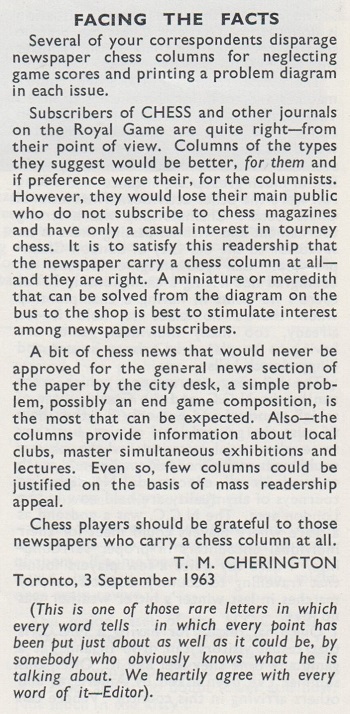
The letter was called ‘excellent’ by C.H.O’D. Alexander on page 32 of the mid-October 1963 issue of CHESS.
Page 6 of Chess Review, January 1954 had a brief note on T.M. Cherington:
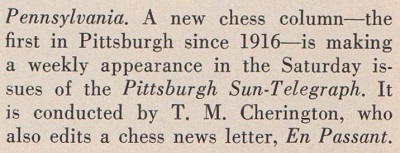
11198. Past and present
An addition to Chess: The Greatest is this passage by C.H.O’D. Alexander on pages 21-22 of Chess Treasury of the Air by Terence Tiller (Harmondsworth, 1966):
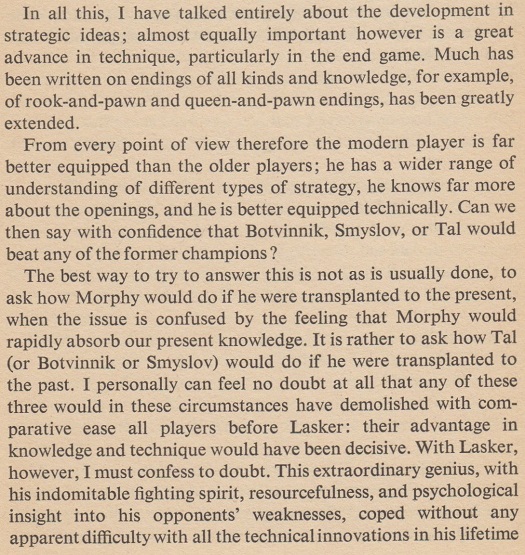
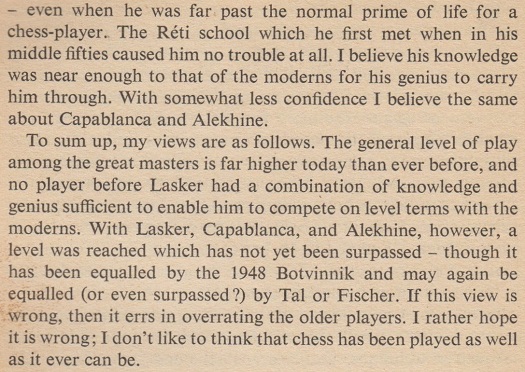
11199. Reshevsky’s date of birth
As mentioned on page 259 of Chess Explorations and in C.N. 1943 (see pages 202-203 of Kings, Commoners and Knaves), a claim emerged in the early 1990s that Samuel Reshevsky was born in 1909 and not, as commonly accepted, in 1911.
The matter is discussed by Bruce Monson in an article about Reshevsky on pages 46-55 of the 1/2019 New in Chess.
11200. Reshevsky with Marshall and Hodges
From page 14 of the Boston Post, 11 November 1920:

The three-mover by A.B. Hodges which Reshevsky solved in 30 seconds (given at the end of the article):

See too pages 317-318 and 510-511 of Albert Beauregard Hodges by John S. Hilbert and Peter P. Lahde (Jefferson, 2008).
11201. A dog-fight
From the Sunday Times, 7 January 1962, page 38 (magazine section):
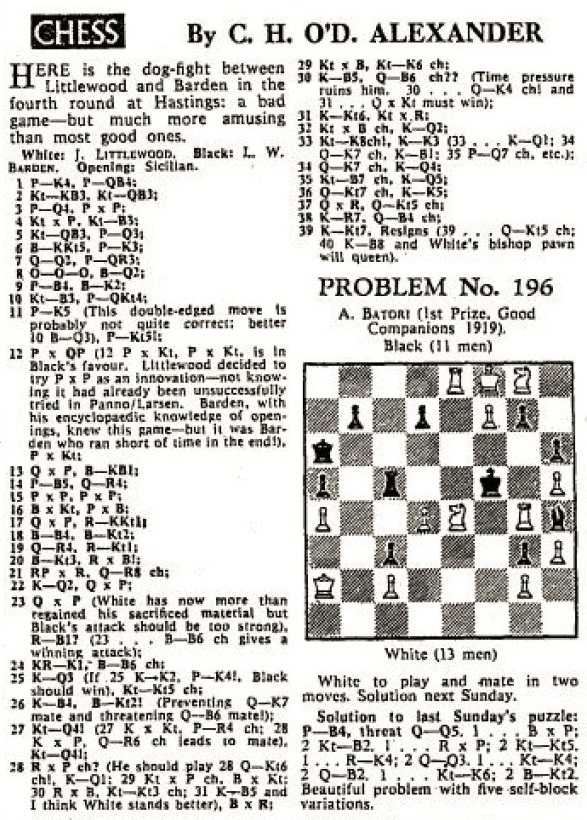
1 e4 c5 2 Nf3 Nc6 3 d4 cxd4 4 Nxd4 Nf6 5 Nc3 d6 6 Bg5 e6 7 Qd2 a6 8 O-O-O Bd7 9 f4 Be7 10 Nf3 b5 11 e5 b4 12 exd6 bxc3 13 Qxc3 Bf8 14 f5 Qa5 15 fxe6 fxe6 16 Bxf6 gxf6 17 Qxf6 Rg8 18 Bc4 Bg7 19 Qh4 Rb8 20 Bb3 Rxb3 21 axb3 Qa1+ 22 Kd2 Qxb2 23 Qxh7 Rf8 24 Rhe1 Bc3+ 25 Kd3 Nb4+ 26 Kc4 Bg7 27 Nd4 Nd5
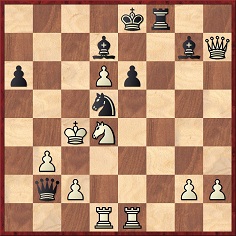
28 Rxe6+ Bxe6 29 Nxe6 Ne3+ 30 Kc5 Qc3+ 31 Kb6 Nxd1 32 Nxg7+ Kd7 33 Ne8+ Ke6 34 Qe7+ Kd5 35 Nc7+ Kd4 36 Qg7+ Ke4 37 Qxf8 Qb4+ 38 Ka7 Qc5+ 39 Kb7 Resigns.
The game was played in round four of the Hastings tournament, on 30 December 1961. White’s final move was not 39 Kb8 as given in some databases. When the ‘dog-fight’, as Alexander termed it, was annotated on pages 134-135 of CHESS, 19 January 1962, his remark, ‘a bad game – but much more amusing than most good ones’, was quoted together with the following:
‘A real English-style game’ (M. Botvinnik).
‘Littlewood plays the best bad chess I have ever seen.’ (L. Lindheimer).
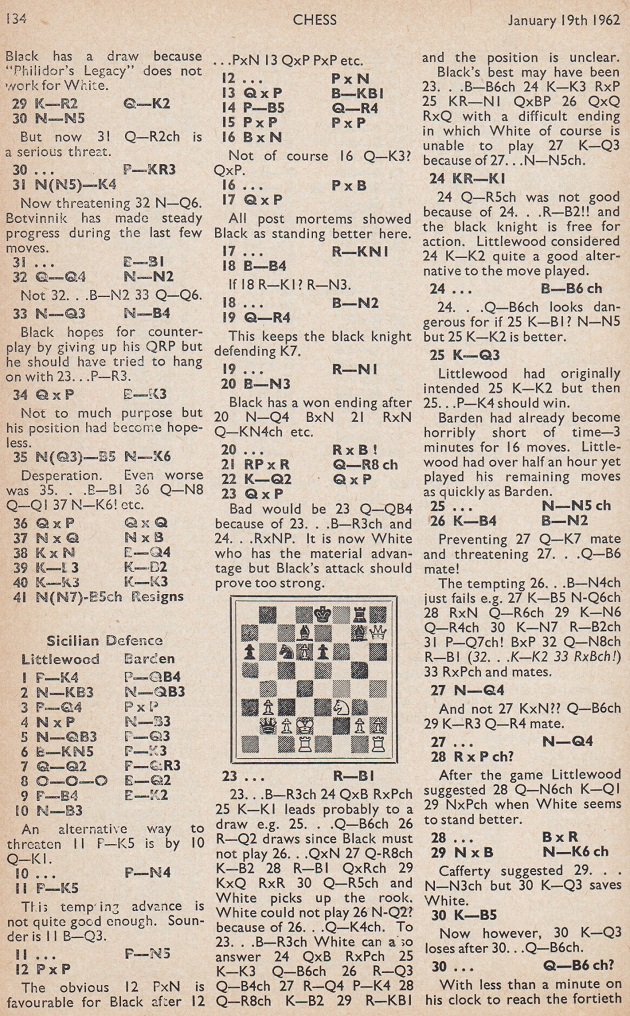
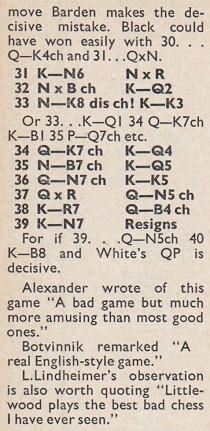
Some complementary notes from Richard Forster (Zurich):
‘14 f5. The whole line appears to be dubious for White. 14 Bc4 was tried in some later grandmaster games, with modest results.
20...Rxb3. 20...Qf5 (Burger-Mednis, New York, 1969) is a good alternative.
24 Rhe1. A new move. 24 Qh5+ Kd8 25 Qh4+ Ke8 26 Qh5+ Rf7 had led to a quick defeat for White in Larsen-Panno, Mar del Plata, 1958. 24 Ke2 had been tried in another earlier game, Holaszek-Minaya Molano, The Hague, 1961; after 24...Nb4 Black still enjoys the better game. 24 Qe4 may be relatively best.
24...Bc3+. An even stronger line is 24...Qc3+! 25 Ke2 Ne5!, as 26 Qxg7 loses to 26...Bb5+ 27 Kf2 Nd3+ 28 Rxd3 Qxg7.
25 Kd3?! Objectively, 25 Ke2 was the lesser evil, although after 25...e5 (26 Rd5) or simply 25...Bxe1 Black keeps the advantage.
25...Nb4+. The mundane 25...Bxe1 26 Rxe1 Qa3 should win quite easily as White loses the d6 pawn.
26...Bg7? The third inaccuracy in a row and quite a significant one. Firstly, 26...Rf4+ is stronger. Retreating the knight to c6 also keeps a clear advantage. After the game move, White could have forced a draw by perpetual check with 27 Qh5+! Kd8 28 Qa5+ Ke8 29 Qh5+ since 29... Rf7 30 Ne5 is plainly bad.
27...Nd5? Here the unusual 27...Na2! with the same threat was much stronger. The point is that unlike in the game the knight is not attacked by the king. After 28 Re3 Bb5+ 29 Nxb5 axb5+ 30 Kd3 (30 Kxb5 Kd7!) 30...Qd4+ 31 Ke2 Nc3+ 32 Rxc3 Qxc3 33 d7+ Kd8 Black ought to win.
28 Rxe6+? 28 Qg6+ Kd8 29 Nxe6+ is indeed better, but it is still White who must be glad that after 29...Bxe6 30 Rxe6 Nb6+ 31 Kd3 Qd4+ 32 Ke2 Qf2+ 33 Kd3 Black has no more than perpetual check.
30 Kc5. White is still lost. After 30 Kb4 Black would need to find 30...Qc3+ 31 Ka4 Rf4+!! 32 Nxf4 Qc6+ 33 Ka3 Qc5+ 34 b4 Nxc2+ with a mating attack (35 Ka2 Qc4+).
30...Qc3+? The turning point. 30...Qe5+ 31 Kb6 Qxe6 does indeed win easily.
31...Nxd1. There is no salvation: 31...Qb4+ 32 Kxa6! Qa3+ 33 Kb5 Rf5+ 34 Qxf5 Nxf5 35 d7+ and wins. 31...Rf7 32 Qg8+ Bf8 33 d7+. Or 31...Nf5 32 Qg6+! (not 32 Nxf8? Bd4+) 32...Kd7 33 Nxf8+, etc.’
Leonard Barden’s obituary of John Littlewood (Guardian, 26 September 2009) described him as ‘the finest UK attacking player of his generation’.
Littlewood was also praised by William Lombardy on pages 36-37 of Chess Life, February 1962. For example:
‘It is easy to see how Littlewood could beat any player at any given time, since he does not appear to be in the least timid about sacrificing material early in the game.’
On page 72 of the March 1962 Chess Review Bruce Hayden reported that on the evening of 28 December 1961 Littlewood was referred to by visiting masters as ‘der kleine Tal’ after his spectacular, though unsuccessful, attack against Botvinnik in the Hastings tournament. The world champion annotated the game on pages 129-130 of CHESS, 19 January 1962.
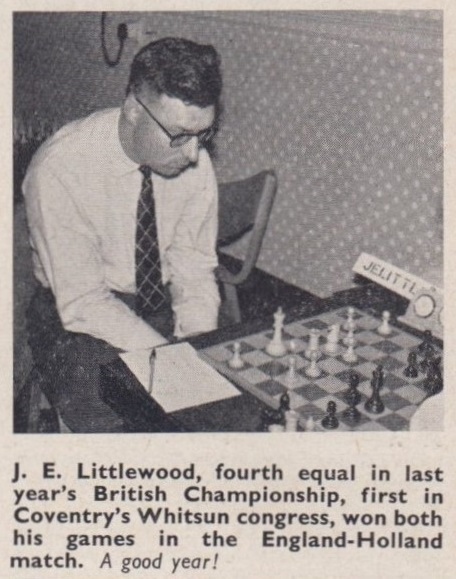
CHESS, 25 November 1960, page 93.
11202. L. Lindheimer
Information is sought on L. Lindheimer, who was mentioned in the previous item.
From page 325 of the November 1962 BCM:

A photograph on page 221 of CHESS, 28 April 1956:
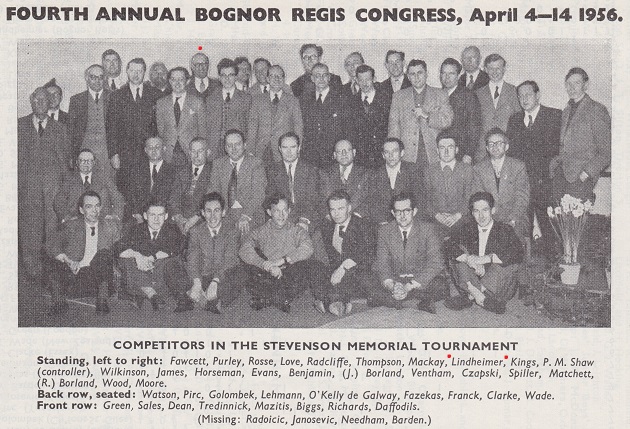
11203. Costumes for living chess
A brief item on page 268 of CHESS, 23 June 1962:
‘The German magazine Schach has an advertisement by a Leipzig firm offering costumes for living chess displays, “very beautiful, reasonably priced”.’
Peter Anderberg (Harmstorf, Germany) notes that the advertisement, placed by Felix Semmler, was in the May and June 1962 issues of Schach, on pages 160 and 192 respectively:

11204. The antidote for the poison in gambits
From the inside front cover of Chess Review, January 1954, in ‘Chernev’s Chess Corner’:

What is known about any such remark?
11205. Hönlinger v Eliskases
The final game in Chess Strategy and Tactics by Fred Reinfeld and Irving Chernev (New York, 1933) began as follows, on page 99:
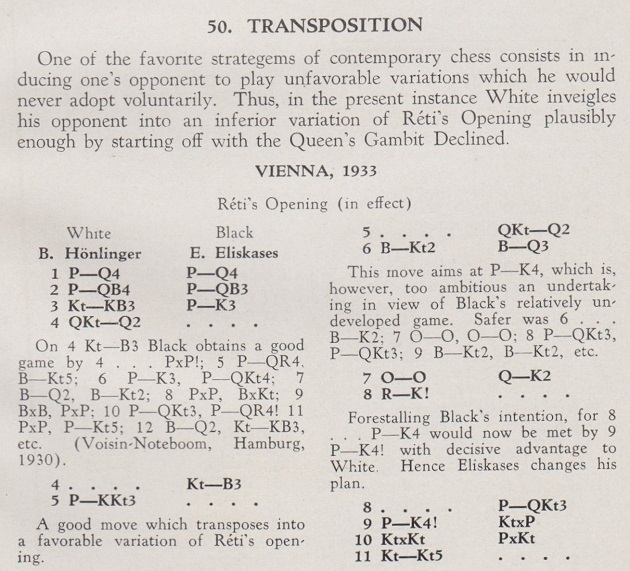
1 d4 d5 2 c4 c6 3 Nf3 e6 4 Nbd2 Nf6 5 g3 Nbd7 6 Bg2 Bd6 7 O-O Qe7 8 Re1 b6 9 e4 Nxe4 10 Nxe4 dxe4 11 Ng5 Bb7 12 Nxe4 Bc7 13 d5 cxd5 14 cxd5 Bxd5 15 Bg5 f6 16 Nxf6+ Nxf6 17 Bxf6 Qxf6 18 Bxd5 O-O-O 19 Bxe6+ Kb8 20 Qc2 Be5 21 Bh3 Bxb2 22 Bg2 Rhe8 23 Rxe8 Rxe8
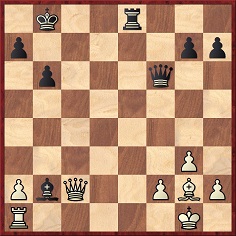
24 Rf1 g6 25 Qb3 Rd8 26 Qe3 Qf5 27 Qe7 Rd7 28 Qe8+ Kc7 29 Qa8 Bd4 30 Qxa7+ Kd8 31 Qb8+ Ke7 32 Bc6 Be5 33 Bxd7 Bxb8 34 Bxf5 gxf5 35 Rd1 Bd6 36 Rd4 Bc5 37 Rh4 Resigns.
Strange to say, we have not seen this ‘beautifully played game on the part of Hönlinger’ in any database. It had appeared with the same notes, ascribed to Reinfeld alone, on pages 13-14 of the May 1933 Chess Review. The occasion was given as ‘Vienna, March 1933’, but below is the heading on page 366 of the December 1932 Wiener Schachzeitung:
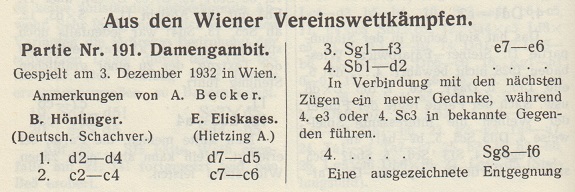
See too pages 88-90 of the March 1933 Deutsche Schachzeitung, which reproduced Hans Kmoch’s annotations from the Neues Wiener Journal.
11206. Oskam v Reyss
Oskam v Reyss, Rotterdam, 1931 is another forgotten game, although it was even described as ‘immortal’ by Albert Becker in the April 1932 Wiener Schachzeitung (pages 109-110):
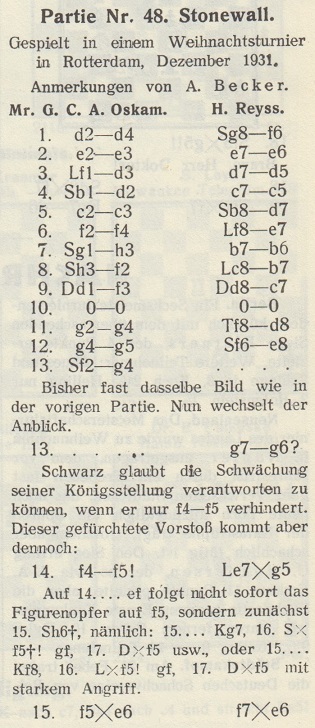

The ‘immortal’ reference was mentioned on page 173 of the July 1932 Tijdschrift van den Nederlandschen Schaakbond:
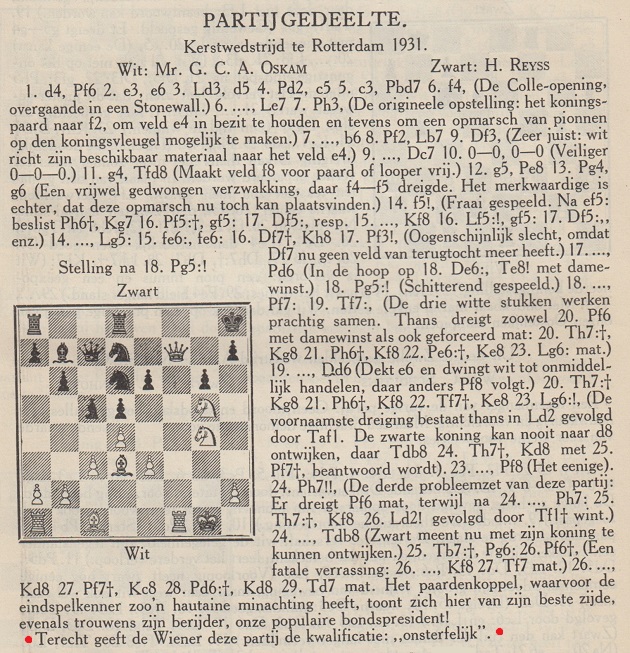
1 d4 Nf6 2 e3 e6 3 Bd3 d5 4 Nd2 c5 5 c3 Nbd7 6 f4 Be7 7 Nh3 b6 8 Nf2 Bb7 9 Qf3 Qc7 10 O-O O-O 11 g4 Rfd8 12 g5 Ne8 13 Ng4 g6 14 f5 Bxg5 15 fxe6 fxe6 16 Qf7+ Kh8 17 Nf3 Nd6 18 Nxg5 Nxf7 19 Rxf7 Qd6 20 Rxh7+ Kg8 21 Nh6+ Kf8 22 Rf7+ Ke8 23 Bxg6 Nf8
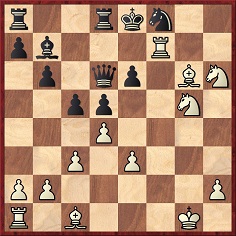
24 Nh7 Rdb8 25 Rxb7+ Nxg6 26 Nf6+ Kd8 27 Nf7+ Kc8 28 Nxd6+ Kd8 29 Rd7 mate.
The game was also annotated by J.H. Blake on pages 223-224 of the May 1932 BCM.
| First column | << previous | Archives [174] | next >> | Current column |
Copyright: Edward Winter. All rights reserved.


